Nemesia arenifera
Nemesia arenifera Bester & H.M.Steyn
Family: Scrophulariaceae
Common names: None recorded.
Introduction
The newest nemesia, Nemesia arenifera, was described in 2013 as a new species. It has been overlooked since 1904, as it was confused with Nemesia viscosa. It grows on sandy soils in the coastal zone of Namaqualand and is a locally common and widespread plant. Diagnostic characters of N. arenifera include the erect, sparsely branched habit, small yellow flowers, the orientation of the spur, and the densely sticky, glandular hairy indumentum.

Description
Description
This is an annual, erect herb, with simple or branched stems, 40–300 mm high. All parts of the plants are glandular pilose, except most of the corolla. The leaves are simple, mostly opposite and sessile to shortly petiolate. The blade is narrowly lanceolate and sparsely toothed.

The calyx is 5-lobed, weakly 2-lipped with 2 lobes somewhat broader than the other 3. The flowers are mostly solitary in axils or in lax racemes, up to 80 mm long, small, 5-lobed and strongly 2-lipped with the upper lip 4-lobed and lower lip 1–lobed, entirely yellow but sometimes with faint magenta streaks on the lower lobe. The tube is very short and drawn out into a conical, single spur that is 2–5 mm long and held ± parallel to the pedicel. Stamens are 4, of 2 different lengths, s-twisted around each other.
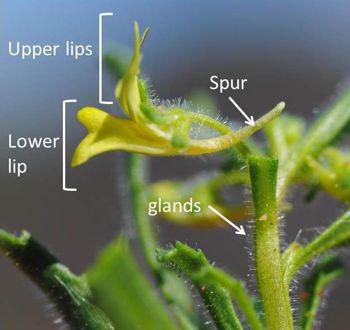
Capsules are ± oblong-ovoid in outline, 4–11 × 4–5 mm, laterally compressed with a notched or bi-lobed apex.
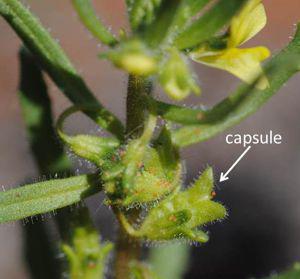
Seeds are widely ovate, ± 1 × 0.3–1.7 mm, light brown, with wart-like surface and with membranous wings. Flowering and fruiting takes place during August–September.
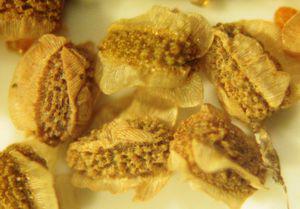
Conservation Status
Status
Nemesia arenifera currently has a threat status of LC (Least Concern). Despite having a restricted range, it is fairly common. Some of the populations may be declining due to habitat loss because of mining, but this represents a low percentage of its full distribution range.
Distribution and habitat
Distribution description
This species is restricted to the arid coastal dune systems in Namaqualand, Northern Cape Province, South Africa. It occurs from Alexander Bay in the north to Groen River Mouth in the south, at an altitude below 300 m above sea level. From current distribution records, it seems to be a Northern Cape, coastal endemic.
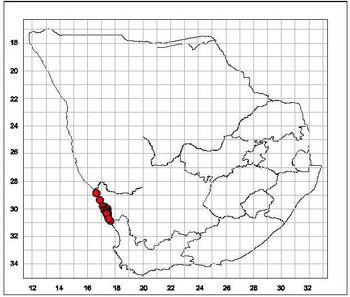
It occurs in deep, loose wind-blown sand, ranging from white through yellow to red.
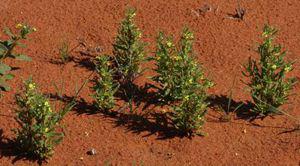
This species is known only from the Namaqualand Sandveld Bioregion and Sand Fynbos Bioregion within the Succulent Karoo and Fynbos Biomes respectively. Winter rains are predominant in these areas between May and August with an average of 50–114 mm per annum. Dense fog, especially in winter, contributes to the precipitation, and frost is very rare.
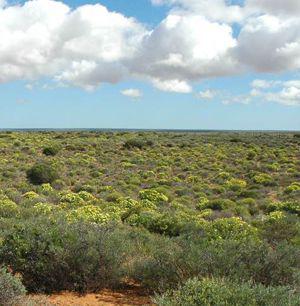
Derivation of name and historical aspects
History
The genus Nemesia is derived from the ancient Greek name for a similar plant called Nemesion. The specific epithet, arenifera (‘sand-loving’) is in reference to the affinity of this species for deep, loose, sandy soils. The glands that cover the whole plant surface, exude a sticky substance and sand adheres to this, so the plants are mostly literally ‘covered in sand’!
The genus Nemesia is placed in the snapdragon-family (Scrophulariaceae). It consists of ± 66 species of annual and perennial herbs of which ± 95% are endemic to southern Africa. Most of the southern African species are found in the Western and Northern Cape, and extend into southern Namibia.
Nemesia arenifera does not closely resemble any other Nemesia from southern Africa. Diagnostic characters include the erect habit, small yellow flowers with the spur carried parallel to the pedicel and the sticky indumentum of glands. N. arenifera has long been confused with N. viscosa, from which it differs in habit, leaf and floral characters. Unlike N. arenifera, that inhabits the coastal dune systems along the Atlantic Ocean, N. viscosa is restricted to the dry interior along the Orange River instead.
In N. arenifera, the lower lip of the flower is in line with the spur and parallel to the pedicel — the only other species where this feature is present is N. rupicola from the high Drakensberg Mountains.
Ecology
Ecology
Unlike the relative large flowers of most other Nemesia species, N. arenifera has small flowers, but a single plant produces many flowers. These will probably not attract butterflies, but rather small insects as pollinators.
The winged seed (minute versions of Combretum fruit / samara) are adapted for easy distribution by wind. Plants need to establish quickly and in a short time produce enough seed for the seedbank for the next generation, the rainy season being relatively short.
Uses
Use
No medicinal or cultural uses could be traced for this plant. In the natural vegetation, plants are sparsely distributed, and no evidence of them being grazed has been observed.
Growing Nemesia arenifera
Grow
Nemesia arenifera is an annual and naturally occurs in areas that have relatively low minimum and high maximum temperatures. It is commercially currently not available, but like other nemesias, may be suited for growing en masse in beds or rock gardens, as borders or edging plants or in hanging baskets, containers or window boxes provided the drainage is excellent.
The genus Nemesia is widely cultivated and numerous cultivars and hybrids are available for displays in a spring garden. Most grow in full sun, but some will also do well in semi-shade. Many species are short-lived bedding plants, sow in succession to ensure a long bloom period. The most widely cultivated species are Nemesia strumosa and N. versicolor and their hybrids. Other pure species include N. affinis, N. barbata, N. bicornis, N. caerulea, N. cheiranthus and N. fruticans.
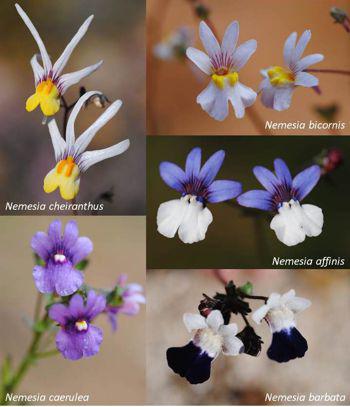
General cultivation notes for Nemesia:
Perennials may be grown from cuttings. Annuals best propagated from seed in autumn or early spring. Sow seed in March (to ± bloom in July–August) in a sandy mix or in vermiculite in autumn, and water regularly throughout the winter. Water from below. Germinate in 1–3 weeks to in a temperature of 12–20°C or longer in cooler areas. Seedlings are easy to transplant, then space them 15–30 cm apart. Plants are grown easily and flower from a young age. A mix of compost and sand provide a good growth mediam. Plants need afternoon shade, good drainage, rich and moist soil with regular feed and watering. Young plants should be pinched back at the tips to promote a bushy growth. Plants are tender to frost in areas of mild winters. They flower on average up to 2 months.
References
- Bester, S.P. & Steyn, H.M. 2013. Nemesia arenifera (Scrophulariaceae), a new species from Sandveld, Northern Cape Province, South Africa, and the lectotypification of N. viscosa. Phytotaxa 126 (1): 49–54.
- Bester, S.P., Steyn, H.M. & Von Staden, L. 2014. Nemesia arenifera Bester & H.M.Steyn. National Assessment: Red List of South African Plants version 2014.1. http://redlist.sanbi.org/ Accessed on 2015/07/20
- Eliovson, S. 1973. South African wild flowers for the garden. Macmillan, Johannesburg.
- Eliovson, S. 1974. The complete gardening book for South Africa. Macmillan South Africa, Johannesburg.
- Fabian, A. & Germishuizen, G. 1997. Wild flowers of northern South Africa. Fernwood Press, Vlaeberg.
- Hiern, W.P. 1904. Nemesia. In W.T. Thiselton-Dyer, Flora capensis 4(2): 169–200. Reeve, London.
- http://www.gardenershq.com/Nemesia.php. Accessed on 20/07/2015.
- Joffe, P.1993. The gardener’s guide to South African plants. Tafelberg Publishers, Cape Town.
- Leistner, O.A. (ed.). 2000. Seed plants of southern Africa: families and genera. Strelitzia 10. National Botanical Institute, Pretoria.
- Manning, J. 2009. Field guide to wild flowers of South Africa. Struik Nature, Cape Town.
- Mucina, L. & Rutherford, M.C. 2006. The vegetation of South Africa, Lesotho and Swaziland. Strelitzia 19. South African National Biodiversity Institute, Pretoria.
- Van der Spuy, U. 1971. Die groot veldblomboek vir die tuin. Tafelberg, Cape Town.
- Koekemoer, M., Steyn, H.M. & Bester, S.P. 2015. Guide to Plant Families of southern Africa. Strelitzia 31. 2nd ed., 2nd print. South African National Biodiversity Institute, Pretoria, South Africa.
- Pienaar, K. 1992. The South African what flower is that? Struik Publishers, Cape Town.
Credits
S.P. Bester & H.M. Steyn
National Herbarium
August 2015
Plant Attributes:
Plant Type: Bi/Annual
SA Distribution: Northern Cape
Soil type: Sandy
Flowering season: Spring, Early Summer
PH: Neutral
Flower colour: Yellow
Aspect: Full Sun
Gardening skill: Average
Special Features:
Horticultural zones











Rate this article
Article well written and informative
Rate this plant
Is this an interesting plant?
Login to add your Comment
Back to topNot registered yet? Click here to register.